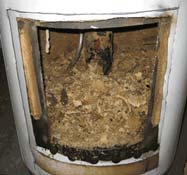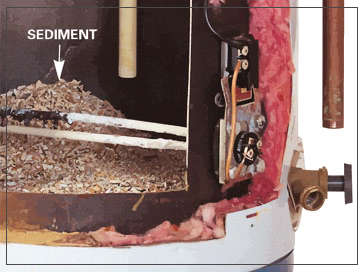Sediment in a water heater can be dangerous. It may lead to reduced efficiency and damage to the appliance over time.
Sediment buildup in water heaters is a common issue, especially in areas with hard water. Over time, minerals like calcium and magnesium accumulate at the bottom of the tank. This sediment can cause various problems, including decreased heating efficiency and increased energy bills.
In severe cases, it may even lead to leaks or tank failures, posing a risk to your home. Regular maintenance and flushing of the water heater can help prevent sediment buildup. Understanding the dangers of sediment in your water heater is essential for ensuring its longevity and maintaining safe water quality. Taking action early can save you money and prevent emergencies down the road.

Credit: www.reddit.com
Page Contents
- 1 Introduction To Sediment Build-up
- 2 Identifying Sediment In Your Water Heater
- 3 Potential Risks Of Ignoring Sediment
- 4 Is Sediment Dangerous?
- 5 Preventive Measures
- 6 Diy Sediment Removal Techniques
- 7 When To Call The Professionals
- 8 Maintaining A Sediment-free Water Heater
- 9 Frequently Asked Questions
- 10 Conclusion
Introduction To Sediment Build-up
Sediment build-up in water heaters can lead to various issues. It occurs over time due to minerals in the water.
Common causes include:
- Hard water: Contains high levels of calcium and magnesium.
- Corrosion: Metal pipes can rust and add debris.
- Low water flow: Slower flow allows sediment to settle.
Different types of sediments may accumulate:
| Type of Sediment | Description |
|---|---|
| Mineral Deposits | Solid minerals like calcium and lime. |
| Rust | Iron corrosion from metal pipes. |
| Sand and Silt | Fine particles from groundwater. |

Credit: www.plumbingsupply.com
Identifying Sediment In Your Water Heater
Identifying sediment in your water heater is important for safety. Look for cloudy water or discolored water. Strange noises, like banging or rumbling, can also indicate sediment buildup.
Check the temperature setting. If it is too high, sediment can form faster. Regularly inspect the drain valve for leaks or clogs.
- Turn off the water heater.
- Connect a hose to the drain valve.
- Open the valve and let water flow out.
- Observe the water for particles or color changes.
- Close the valve when finished.
Potential Risks Of Ignoring Sediment
Ignoring sediment in your water heater can lead to serious issues. It affects the efficiency of the heater. Less efficiency means higher energy bills. Sediment buildup also causes the heater to work harder. This may lead to premature failure of the unit.
Long-term damage can be costly. Repair costs can skyrocket if sediment is not addressed. Replacing a damaged water heater is expensive. Regular maintenance helps avoid these problems. Keeping your water heater clean ensures better performance and longevity.

Credit: anyhourservices.com
Is Sediment Dangerous?
Sediment in a water heater can cause serious health concerns. It may contain harmful bacteria, which can lead to illness. Some sediment types might release toxins, affecting drinking water quality.
Clogged pipes from sediment build-up can also create safety risks. This can lead to water leaks or even explosions in extreme cases. Regular maintenance helps prevent these problems.
| Health Concerns | Safety Risks |
|---|---|
| Harmful bacteria | Clogged pipes |
| Toxins in water | Water leaks |
| Illness from contaminated water | Potential explosions |
Preventive Measures
Regular maintenance is key to keeping your water heater safe. Check the heater every six months. Flush the tank to remove any sediment. This helps improve efficiency and lifespan. Look for rust or discoloration in the water.
Water treatment options can help reduce sediment buildup. Water softeners can remove minerals that cause sediment. Filters can also catch debris before it enters your heater. Using these options will keep your water cleaner.
| Maintenance Routine | Frequency |
|---|---|
| Tank Flushing | Every 6 months |
| Check for Rust | Every month |
| Inspect Anode Rod | Every 1-2 years |
Diy Sediment Removal Techniques
Removing sediment from your water heater is essential for efficiency. Start with the right tools and safety gear. You will need a bucket, a garden hose, and safety goggles. Gloves are also important to protect your hands.
First, turn off the power supply to the water heater. Next, connect the garden hose to the drain valve. Place the other end of the hose into your bucket.
Open the drain valve slowly. Let the water flow out until it runs clear. This removes most of the sediment. Close the drain valve and disconnect the hose.
Turn the power back on and let the heater refill. Regular sediment removal keeps your water heater in good shape.
When To Call The Professionals
Finding sediment in your water heater can be a sign of trouble. Watch for strange noises or cloudy water. These may indicate that sediment buildup is affecting performance.
Other signs include low water pressure and hot water shortages. If you notice these issues, calling a professional is wise. They can inspect and clean your water heater safely.
Choosing the right service is important. Look for companies that have good reviews and experience. Ask about their cleaning methods and costs. This ensures you get the best care for your water heater.
Maintaining A Sediment-free Water Heater
Maintaining a sediment-free water heater is essential for safety and efficiency. Regularly flushing the tank helps remove sediment buildup. This process should be done at least once a year.
Consider using a water softener. It reduces minerals that cause sediment. Replace your anode rod every few years. A good rod can prevent rust and sediment accumulation.
Lifestyle changes can also improve water quality. Use filters for drinking water. They can catch unwanted particles. Limit the use of harsh chemicals in cleaning products. This helps keep the water cleaner.
Educate family members about water conservation. Less water usage means less chance for sediment buildup. Regularly check for leaks to prevent water quality issues.
Frequently Asked Questions
What To Do If Water Heater Is Full Of Sediment?
Flush the water heater to remove sediment. Turn off the power and water supply. Attach a hose to the drain valve and direct it outside or into a bucket. Open the valve and let the water run until clear. Refill the tank and restore power.
Regular maintenance prevents future buildup.
Can Sediment Cause A Hot Water Heater To Stop Working?
Yes, sediment can cause a hot water heater to stop working. It builds up in the tank, reducing efficiency and blocking water flow. Regular flushing of the tank helps prevent sediment buildup and ensures optimal performance. Keeping the heater maintained extends its lifespan and improves water quality.
Should I Drain Sediment From Water Heater?
Yes, you should drain sediment from your water heater regularly. Sediment buildup can reduce efficiency and lifespan. Aim to flush it out annually to maintain optimal performance and water quality. This simple maintenance can save you money on energy bills and repairs in the long run.
Is Sediment Popping In Water Heater Bad?
Sediment popping in a water heater indicates a buildup of minerals. This can cause decreased efficiency and potential damage. Regular flushing can prevent issues and extend the heater’s lifespan. Address sediment buildup promptly to maintain optimal performance and avoid costly repairs.
Conclusion
Sediment buildup in your water heater can pose health risks. It may lead to bacterial growth and reduced efficiency. Regular maintenance is key to preventing these issues. Flushing your water heater annually can help ensure clean, safe water. Protect your home and health by staying proactive about your water heater’s condition.
